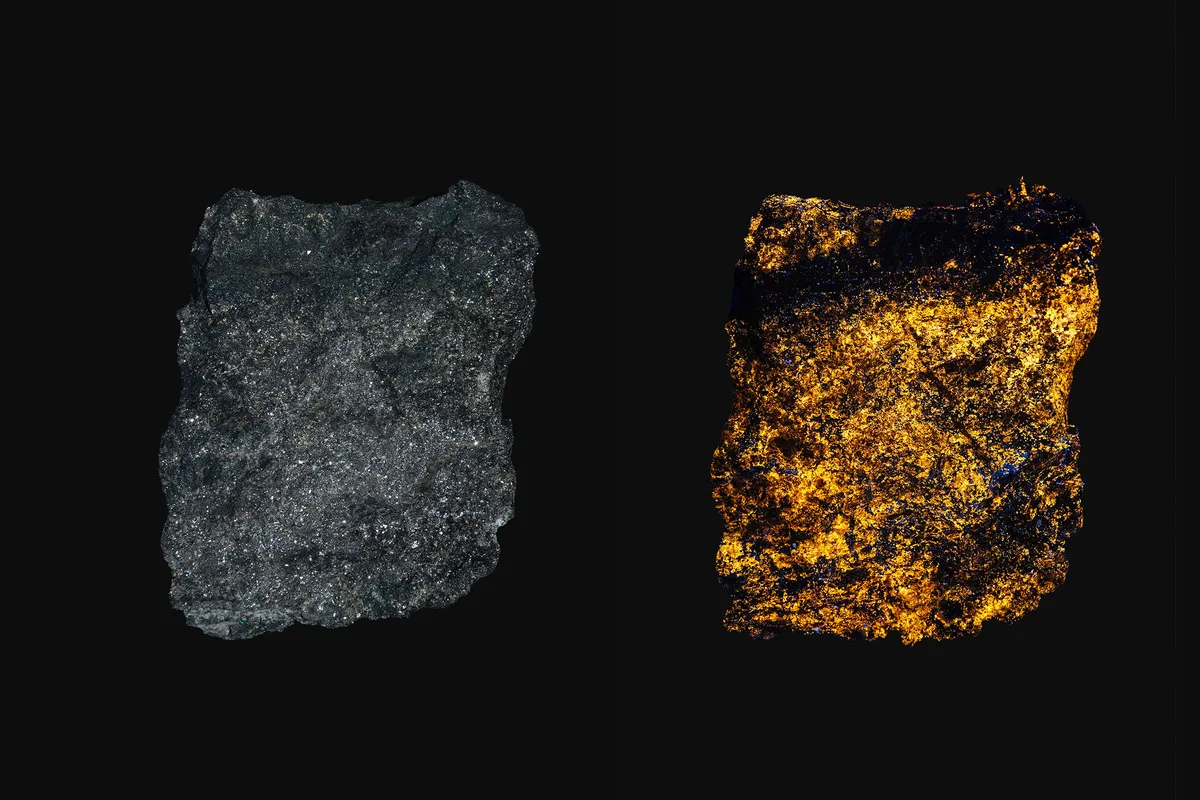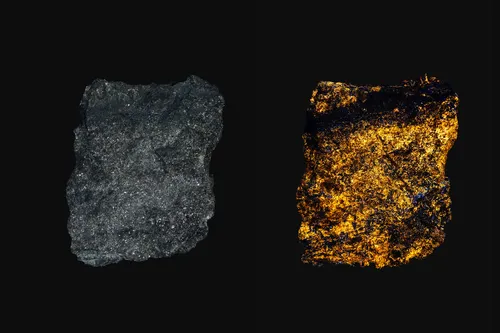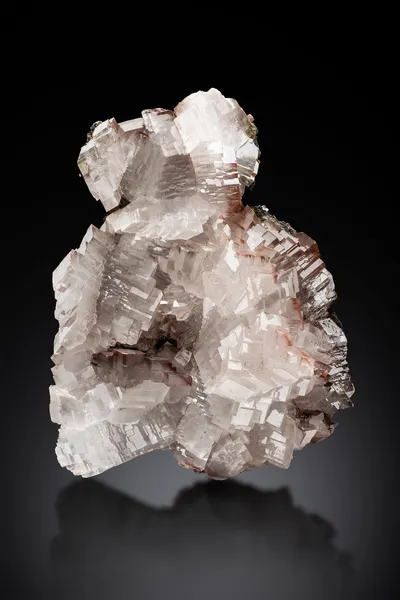
Mineral Species
Sphalerite
Type Locality
No
Composition
ZnS
Crystal System
Cubic
Status at Tsumeb
Confirmed
Abundance
Very common
Distribution
First, second and third oxidation zones; sulphide ores
Paragenesis
Hypogene
Entry Number
Species; TSNB327
General Notes
Sphalerite very rarely forms macroscopic, euhedral crystals at Tsumeb, but it is an economically important component of the massive and disseminated sulphide ores throughout the deposit. The fact that much of the sphalerite at Tsumeb is cadmium enriched was also of economic significance.
Maucher (1908a) described pea-sized to hazelnut-sized aggregates of sphalerite from the upper portion of the first oxidisation zone. He commented that some of the sphalerite has a dirty green colour and is enriched in cadmium. He also noted its triboluminescent properties.
Spencer (1927) noted a strong fluorescent response to ultraviolet radiation from Tsumeb sphalerite and commented on its triboluminescence:
"The most striking fluorescent effect of all [the minerals tested] was that given by a massive granular black blende from Tsumeb, South-West Africa. This was tried because it shows a very pronounced triboluminescence: when lightly scratched with a knife-blade it gives streaks of yellow sparks. In ultraviolet rays it glows with a brilliant fiery yellow like a live coal."
Klein (1938) considered sphalerite to be the only primary zinc mineral "… throughout the deposit". He observed "beautiful examples" of sphalerite "floating" in chalcocite ore but stated that "… crystals are absent." Klein’s "floating" sphalerite presumably referred to isolated crystalline aggregates embedded in chalcocite, although Pinch and Wilson (1977) appear to have interpreted his description as "… euhedral crystals completely embedded in chalcocite …".
Crystallised specimens of sphalerite from the first oxidation zone are certainly rare, but the Klein Collection at Harvard University includes two examples of sphalerite as framboidal aggregates (to about 12 mm) comprising tiny but discernible sphalerite crystals (catalogue numbers MGMH 127244 and 127345). Klein’s handwritten catalogue (unpublished, Klein family archive) confirms that both specimens (Klein 998 and 999) were recovered from 8 Level West.
Lombaard et al. (1986) noted that the iron content of sphalerite increases with depth in the ore body. Samples of sphalerite from between surface and 30 Level returned assays ranging from 0.17 to 0.63 wt % Fe; samples from between 30 and 34 levels contained between 1.52 to 1.73 % Fe while a single specimen from 38 Level was found to contain 4.6% Fe.
Lombaard et al. (1986) also recorded that Tsumeb sphalerite contains up to 150 ppm mercury, a theme pursued by Hughes (1987) who confirmed the presence of metacinnabar as very rare inclusions in sphalerite and, citing Tauson and Abramovich (1980), speculated that mercury might be an activator for the observed red fluorescence.
Tsumeb sphalerite is cadmium-enriched. Schneiderhöhn (1929) noted cadmium contents of up to 3 wt % (which, according to Hughes (1987) is the maximum recorded); Lombaard et al. (1986) indicated an average cadmium content of approximately 1.4 wt %.
Hughes (1987) recognised three varieties of sphalerite based on ore microscopy studies:
- "Grey sphalerite" is most abundant, particularly in lead-zinc ore.
- "Brown sphalerite" is most commonly found in the upper levels of the mine and typically in enargite-rich lead-copper and copper ores.
- "Green sphalerite" is relatively rare, accounting for approximately 5% of all sphalerite and most commonly occurring in germanium-rich ores. According to Hughes (1987; citing unpublished TCL reports by Geier) "The variety of sphalerite associated with germanium minerals, gallite, tin minerals, cadmium-wurtzite, sulvanite, molybdenite and tungstenite is invariably the rare, light green type.
Keller (1977a) considered sphalerite to be older than enargite, tennantite and galena in the hypogene paragenesis. Keller (1984) proposed the following sequence for primary (hypogene) sulphides:
pyrite(i) >> chalcopyrite(i) >> [bornite + germanite(i)] >> [sphalerite + gallite] >> enargite >> [briartite + tennantite] >> pyrite(ii) >> [chalcopyrite(ii) + germanite(ii)] >> renierite >> galena >> digenite (hypogene?)
A somewhat different sequence was proposed by Lombaard et al. (1986) with up to three generations of sphalerite:
[calcite(i) + albite] >> pyrite(i) >> [quartz(i) + dolomite(i)] >> chalcopyrite(i) >> [germanite(i) + sphalerite(?)] + briartite(?)] >> renierite(i) >> germanite(ii – by reaction) >> [molybdenite + tungstenite] >> sphalerite(green) >> gallite >> sphalerite(brown) >> enargite(?) >> [tennantite + bornite] >> [chalcopyrite(ii) + linnaeite] >> galena(i) >> pyrite(ii) >> germanite(iii ?) >> renierite(ii ?) >> galena(ii ?) >> tennantite(ii) >> pyrite(iii) >> quartz(ii) >> [baryte + fluorite] >> dolomite(ii) >> calcite(ii)
Gebhard (1999) recorded a 6 by 3 cm cluster of sphalerite crystals to 30 mm, recovered from 28 Level in the second oxidation zone. In the third oxidation zone, a few specimens of small red sphalerite crystals on dolomite were found.
Associated Minerals
baryte; bornite; briartite; brunogeierite; calcite; chalcocite; chalcopyrite; chlorargyrite; cinnabar; dolomite; edwardsite; enargite; galena; gallite; galloplumbogummite; germanite; germanocolusite; greenockite; gunningite; ktenasite; larsenite; lauraniite; lazaridisite; mathewrogersite; mendipite (?); metacinnabar; molybdenite; niedermayrite; pyrite; quartz; queitite; renierite; rutile; sidpietersite; stannite; sulvanite; tennantite-(Cu); tennantite-(Zn); tungstenite; wurtzite






